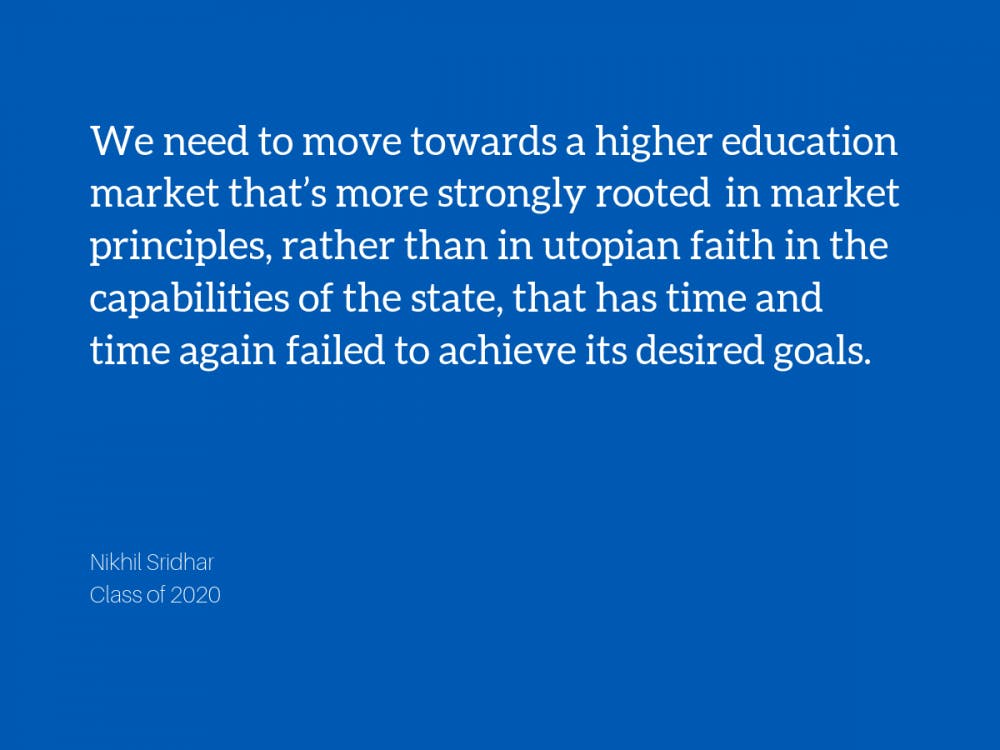In the recent Democratic presidential debate, Senator Elizabeth Warren reflected the concerns of millions of Americans, Republicans and Democrats, when she voiced her plan to cancel student debt for 95 percent of Americans. As the student loan bubble becomes increasingly large, the nitty gritty of the policy surrounding government loans moves further into the sphere of mainstream political discourse.
However, much of the rhetoric on both sides is more emotionally driven rather than grounded in theory and history. A more informed perspective might suggest hands-off approach to student loan policy that can help ensure more macroeconomic stability and long-term prosperity. Of course, while it is difficult to address all the intricacies of student loan policy in a single column, hopefully my admittedly heterodox perspective might get more politically engaged students interested in alternative policy prescriptions.
The government really started to get involved with student loans in 1958, with the Federal Perkins Loan program and the National Defense Student Loan program. The Perkins Loan was a needs-based program that offered loans at a 5% fixed interest rate. In 1965, with the first iteration of the Higher Education Act, doubled down on state intervention in the student loan sphere by establishing a guaranteed student loan program, through the Federal Family Education Loan Program. Since then, the federal government has proceeded to interfere more and more in the loan market, distorting outcomes further, leading to a history of significant instability.
Over the summer, I had the opportunity to skim nearly all the Government Accountability Office (GAO) and Congressional Research Service (CRS) reports pertaining to student loan policy. The vast majority of these reports were either complaints or warnings about bad incentives, overly cheap credit, a lack of accountability, corruption, and general waste due to an immunity from market signals. It is clear that, since credit is too cheap, too many people are borrowing too much money, and they simply can’t afford to pay back much of their loans. Beyond that, state-controlled bureaucracy is not susceptible to the pressures of market-based competition, leading to bloated administrations, unbalanced budgets, and painfully substandard service.
Instead of handing the state more responsibility, as nearly all politicians, regardless of stripe, seem bent on doing, perhaps we should consider scaling back the role of the state in allocating scarce credit, and hand that duty back to the market. The price system is the only way of aggregating the preferences and resource constraints of all participants in the economy. Without market-determined rates, risk is too subsidized, and the consequences of overly subsidized risks are all too familiar to macroeconomists who saw what cheap credit did to the housing market in 2008.
But what do we do with all of our current student debt? Cancel it? Such an attempt would be a $1.6 trillion bill that the taxpayers will have to foot, which is roughly three times as large as yearly Medicare spending. Not only would it create enormous moral hazard for future borrowers, who might see periodic bailouts as inevitable, and borrow for education that they do not need, and will likely not use, but even a one-time bailout would disproportionately benefit the wealthy by a staggering amount (about half of all student loan debt is held by the top 25% of households by income). Such an enormous subsidy would also do little to curb the rising costs of education that have been plaguing American families for years and would probably incentivize colleges to increase costs even more, given the increased demand that subsidies create.
Also at the core of this issue is the culture that suggests that everyone needs some degree. Many jobs don’t in fact need training at the college level, and more people are paying for degrees that simply don’t have the same payoff that they used to. What we might need is a fundamental shift in our educational system that prioritizes practical, job-related skills.
More urgently, however, we need to move towards a higher education market that’s more strongly rooted in market principles, rather than in utopian faith in the capabilities of the state, that has time and time again failed to achieve its desired goals.
Nikhil Sridhar is a Trinity senior. His column "laissez faire et laissez passer" runs on alternate Mondays.
Get The Chronicle straight to your inbox
Sign up for our weekly newsletter. Cancel at any time.

